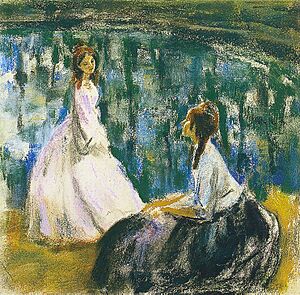Victor Borisov-Musatov facts for kids
Quick facts for kids
Victor Borisov-Musatov
|
|
|---|---|

Self-portrait
|
|
| Born | 14 April 1870 Saratov, Saratov Governorate, Russian Empire
|
| Died | 8 November 1905 (aged 35) Tarusa, Kaluga Governorate, Russian Empire
|
| Nationality | Russian |
| Known for | Painting |
| Movement | Symbolism |
Victor Elpidiforovich Borisov-Musatov (Russian: Ви́ктор Эльпидифо́рович Бори́сов-Муса́тов; April 14, 1870 – November 8, 1905) was a Russian painter. He was known for his special painting style. It mixed ideas from Post-Impressionism, Symbolism, and realism. Many people see him and Mikhail Vrubel as the creators of the Russian Symbolism art style.
Contents
Victor Borisov-Musatov's Life
Early Life and Art School
Victor Musatov was born in Saratov, which was part of the Russian Empire. He later added "Borisov" to his last name. His father worked for the railway and had been born as a serf, which meant he was not free.
When Victor was a child, he hurt his spine. This injury caused him to have a curved back for the rest of his life. In 1884, he went to a school in Saratov. There, his teachers, Fedor Vasiliev and Konovalov, noticed his amazing talent for art.
In 1890, Victor started studying at the Moscow School of Painting, Sculpture and Architecture. The next year, he moved to the Imperial Academy of Arts in Saint-Petersburg. He learned from a teacher named Pavel Chistyakov there.
However, the wet weather in Saint-Petersburg was not good for Victor's health. So, in 1893, he had to go back to Moscow. He rejoined the Moscow School of Painting, Sculpture and Architecture.
Developing His Unique Style
Some of Victor's early paintings, like May Flowers (1894), were called "decadent" by the school. They criticized him for making girls and apple trees look too similar in his art. But other students loved his work. They saw him as a leader of a new art movement.
In 1895, Victor left the Moscow school again. He went to Paris, France, to study at Fernand Cormon's school. He spent three years there, going back to Saratov in the summers. He was very interested in the art of French painters. He especially admired Pierre Puvis de Chavannes, who is called "the father of French Symbolism," and Berthe Morisot.
When Borisov-Musatov returned to Russia in 1898, he felt a strong sense of sadness for the past. He often complained about how difficult and boring life was. He also had money problems, which only got better in his last years when people started buying his paintings.
To deal with these feelings, Musatov began to create a dream-like world in his art. This world showed the fancy life of 19th-century noble families, their parks, and country homes. He based some of these scenes on a real estate called Zubrilovka, but much of it came from his own imagination.
Victor also stopped using oil paints. Instead, he used a mix of tempera and watercolor paints, along with pastels. He found these materials better for creating the soft, subtle effects he wanted in his art.
Art Groups and Famous Works
Borisov-Musatov was part of the Union of Russian Artists. He also helped start and lead the Moscow Association of Artists. This was a group of modern artists that included Pavel Kuznetsov, Peter Utkin, Alexander Matveyev, Martiros Saryan, Nikolai Sapunov, and Sergei Sudeikin.
One of his most famous paintings from this time is The Pool (1902). It shows two important women in his life: his sister, Yelena Musatova, and his future wife, Yelena Alexandrova. The people in the painting blend into the beautiful landscape of the Zubrilovka estate, with its old park and pond.
Another well-known painting is The Phantoms (1903). This artwork shows ghost-like figures on the steps of an old country house. Famous Symbolist poets like Valery Bryusov and Andrey Bely praised this painting.
In 1904, Borisov-Musatov had a very successful art show in several cities in Germany. In the spring of 1905, he showed his work with the Salon de la Société des Artistes Français in Paris. He even became a member of this important French art society.
His last finished painting was Requiem. He created it to remember Nadezhda Staniukovich, a close friend. This painting might show that Borisov-Musatov was starting to move towards a Neo-classical art style.
Victor Borisov-Musatov died on November 8, 1905, from a heart attack. He is buried on the bank of the Oka River near Tarusa. A sculpture of a sleeping boy, made by his follower Alexander Matveyev, marks his tomb.
More Selected Works
See also
- List of Russian artists












